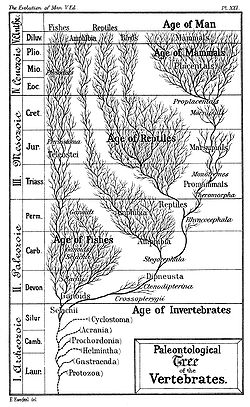Lactase persistence or lactose tolerance is the continued activity of the lactase enzyme in adulthood, allowing the digestion of lactose in milk. In most...
64 KB (7,417 words) - 13:17, 28 June 2025
the recent evolution of lactase persistence in some cultures, which extends lactose tolerance into adulthood. Lactase persistence evolved in several populations...
68 KB (7,078 words) - 09:00, 1 August 2025
lactose in breast milk or formula. Some population segments exhibit lactase persistence resulting from a mutation that is postulated to have occurred 5,000–10...
22 KB (2,101 words) - 17:09, 17 July 2025
Western Steppe Herders (section Lactase persistence)
had a frequency of over 25% of an allele that is associated with lactase persistence, conferring lactose tolerance into adulthood. Steppe-derived populations...
58 KB (6,356 words) - 09:02, 1 August 2025
tested. It has been hypothesized that an allele associated with lactase persistence (conferring lactose tolerance into adulthood) was brought to Europe...
70 KB (7,208 words) - 10:19, 1 August 2025
to contagious diseases (such as malaria), light skin, blue eyes, lactase persistence (or the ability to digest milk after weaning), lower blood pressure...
100 KB (11,719 words) - 12:42, 23 July 2025
Polymorphism 13.9 kb Upstream of the Lactase Gene (LCT) (C−13.9kbT) Does Not Predict or Cause the Lactase-Persistence Phenotype in Africans". The American...
129 KB (13,259 words) - 01:04, 27 July 2025
History of North Africa (section Lactase Persistence)
Africa and the Near East, may have been the source population for lactase persistence variants, including –13910*T, and may have been subsequently supplanted...
63 KB (5,654 words) - 21:06, 23 June 2025
hair, and dark or dark-to-black skin, with no genetic adaption for lactase persistence into adulthood. The near-complete skeleton, an adult male who probably...
23 KB (2,519 words) - 21:19, 19 July 2025
world's highest frequencies of the R-L21 Y-chromosome haplotype and lactase persistence (the ability to digest milk into adulthood) are found among people...
100 KB (9,756 words) - 02:53, 22 July 2025
lactose intolerance, and specifically the presence of the -13910T lactase persistence mutation, found in Europe and Central Asia, across South Asia. In...
240 KB (28,103 words) - 06:08, 19 July 2025
Genetic history of Africa (section Lactase persistence)
Africa and the Near East, may have been the source population for lactase persistence variants, including –13910*T, and may have been subsequently supplanted...
151 KB (16,174 words) - 22:31, 17 July 2025
East Asian types of ADH1B associated with rice domestication, or lactase persistence, are due to recent selection pressures. An even more recent adaptation...
116 KB (12,604 words) - 22:05, 29 July 2025
products. The ability for adult humans to digest milk relies on lactase persistence, so lactose intolerant individuals have trouble digesting lactose...
153 KB (15,811 words) - 10:37, 28 July 2025
Swallow, Dallas M.; Thomas, Mark G. (2011-03-27). "Evolution of lactase persistence: an example of human niche construction". Philosophical Transactions...
28 KB (2,957 words) - 06:01, 29 June 2025
Ségurel, Laure; Bon, Céline (31 August 2017). "On the Evolution of Lactase Persistence in Humans". Annual Review of Genomics and Human Genetics. 18 (1):...
88 KB (3,543 words) - 06:23, 28 July 2025
Allele age (section Lactase persistence)
condition known as lactase persistence. A study conducted by Sarah Tishkoff and her team shows that the mutation for lactase persistence has been under positive...
12 KB (1,583 words) - 11:36, 4 April 2024
extensively on the evolution of lactase persistence (see Lactose intolerance), the ability of some humans to produce the enzyme lactase throughout their adult...
10 KB (1,209 words) - 05:49, 20 July 2025
Sarah Tishkoff (section Lactase persistence)
three new single-nucleotide polymorphisms (SNPs) associated with lactase persistence (G/C-14010, T/G-13915 and C/G-13907) among ethnic groups in East...
36 KB (4,150 words) - 20:13, 8 November 2023
Culture can profoundly influence gene frequencies in a population. Lactase persistence One of the best known examples is the prevalence of the genotype...
68 KB (8,251 words) - 17:51, 20 July 2025
on lactase persistence polymorphism of 23 elite and commoner samples from the 10-11th century found that their low prevalence of lactase persistence "corresponds...
112 KB (14,103 words) - 09:11, 15 July 2025
Africa and the Middle East, may have been the source population for lactase persistence variants, including –13910*T, and may have been subsequently supplanted...
190 KB (21,026 words) - 16:12, 27 July 2025
of Indian and European Cattle Share their Predominant Allele for Lactase Persistence". Mol. Biol. Evol. 29 (1): 249–260. doi:10.1093/molbev/msr190. PMID 21836184...
188 KB (21,172 words) - 16:23, 30 July 2025
moderate amounts of fructose and lactose, particularly if they have lactase persistence. A low-FODMAP diet consists of the global restriction of all fermentable...
23 KB (2,365 words) - 22:03, 17 July 2025
settlement, and both evolving and spreading the European alleles for lactase persistence. 3200 BC: Sumerian cuneiform writing system is first used, triggering...
108 KB (9,219 words) - 20:50, 18 July 2025
Africa and the Near East, may have been the source population for lactase persistence variants, including –13910*T, and may have been subsequently supplanted...
32 KB (3,550 words) - 13:51, 28 June 2025
as well as changes in metabolism due to changes in diet, such as lactase persistence. Culturally-driven evolution can defy the expectations of natural...
266 KB (26,524 words) - 10:51, 23 July 2025
these societies developed a lactase persistence by epigenetic inheritance, which means that the milk-digesting enzyme lactase was present in their bodies...
25 KB (2,929 words) - 02:27, 23 July 2025
0132088. PMC 4503422. PMID 26176541. Cramer DW (November 1989). "Lactase persistence and milk consumption as determinants of ovarian cancer risk". American...
25 KB (2,412 words) - 17:22, 16 July 2025
trans-Saharan movement. European autosomal ancestry, mtDNA haplogroups, and lactase persistence alleles have also been identified in African populations that carry...
89 KB (8,429 words) - 23:08, 17 July 2025





















